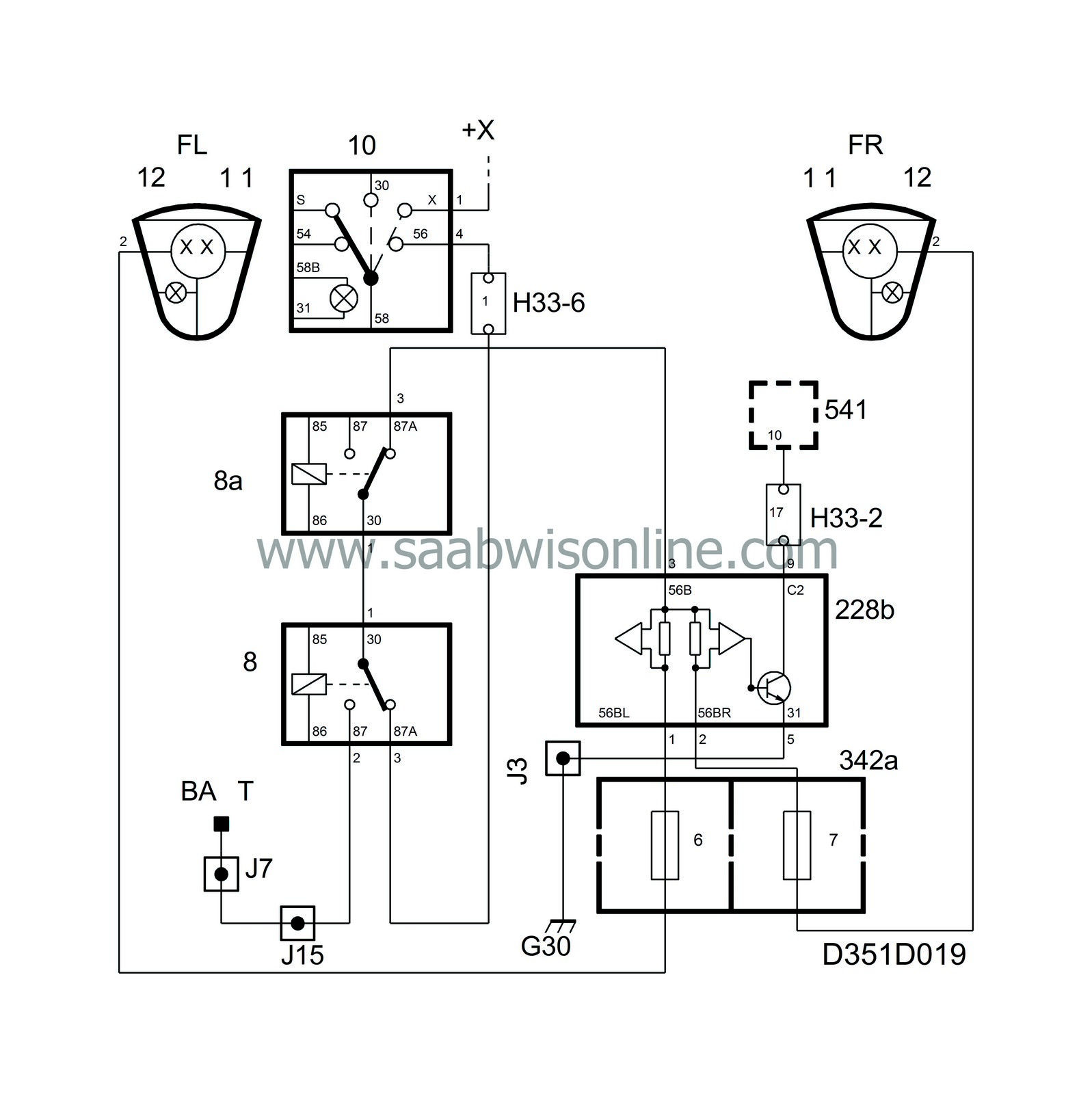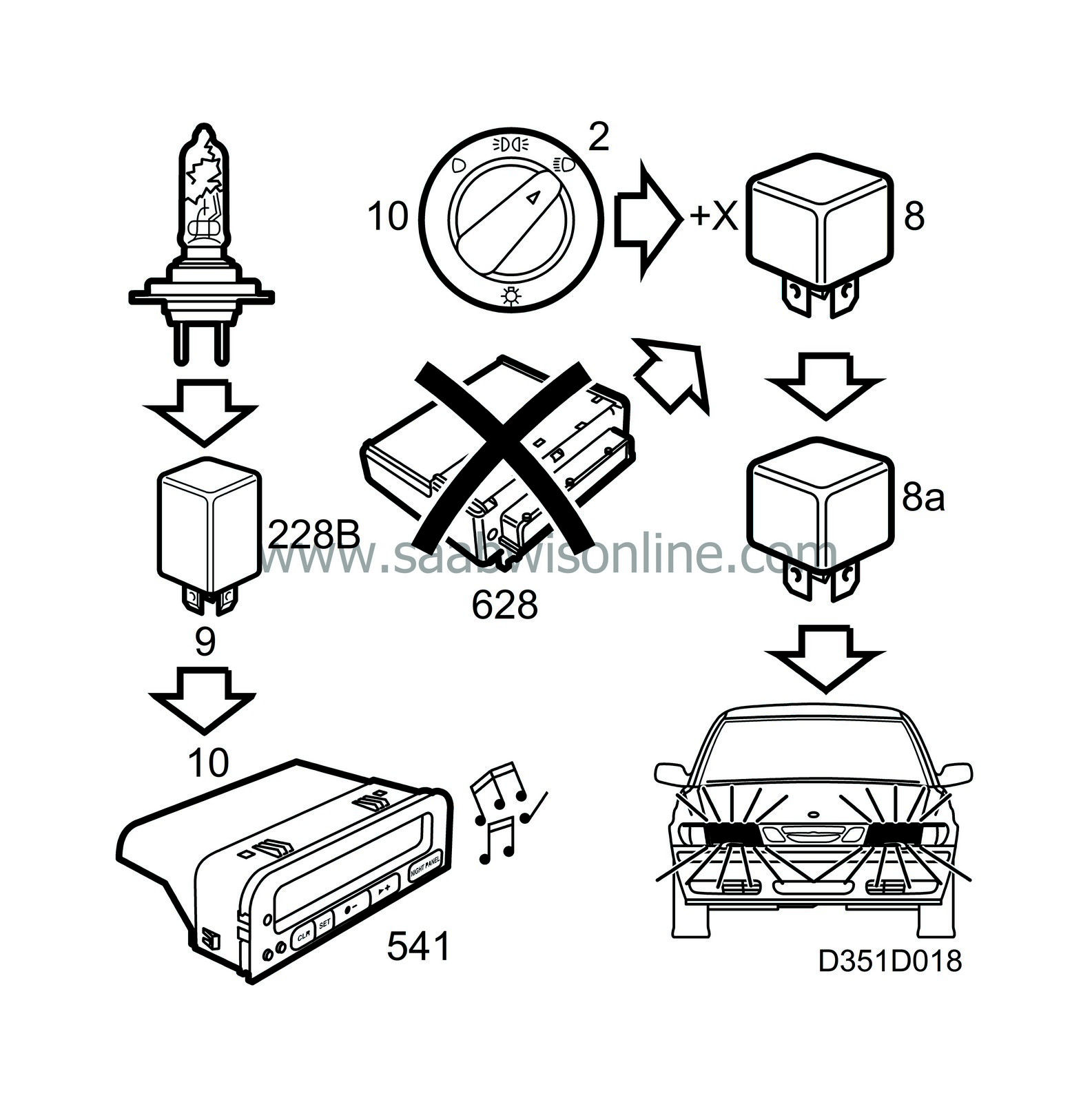Dipped beam
| Dipped beam |

Dipped beam is on when the light switch is in position 2 and the ignition is in position OFF, ON or START. When the ignition is on, the power supply to the dipped beam lamps is controlled by DICE. Dipped beam is used as daylight driving lights on certain markets (light switch in position 0 or 1).
So that DICE can safely determine in which position the switch (10) is, (0-1-2), the control module uses information from TWICE and its own pin connection.
The parking lights are controlled by TWICE which gives information to the bus (ON/OFF). The message ON corresponds to switch position 1 and the message OFF corresponds to switch positions 1 or 2.
To determine which position the switch is in, DICE uses its own pin connections. DICE pin 39 is connected to switch pin 5, which corresponds to position 0. DICE pin 15 is connected to switch pin 4, which corresponds to position 2.
From pin 4 on the light switch (10), voltage +X is fed from the ignition switch to pin 15 on the control module. This causes the main lighting relay to be grounded via pin 4 on the control module and the relay closes. Voltage +30 is fed through the relay via the filament monitor to the fuses (7 and 9).
Limp-home
The limp-home function is a safety circuit in the lighting system which ensures that dipped beams can be used even when DICE is not functioning.When the light switch is in position 2, voltage +X can also be used to power the dipped beam lamps. Voltage +X is fed to the dipped beam relay, which is in the closed, and directly through the relay via the filament monitor (228b) and fuses (6 and 7) to the dipped beam lamps. However, the light from the dipped beams will be somewhat weaker than normal because the voltage drop in the circuit is greater.
| Filament monitor |
The filament monitor 228b is located in the engine bay (relay box). It detects any breaks in the circuit to the dipped beam lamps by measuring the current in the circuit. In the event of an open circuit, the filament monitor pin 5 grounds pin 10 on the SID module. SID displays the message FRONT LIGHT FAILURE.
| Important | ||
|
When changing a bulb, use one with the right output otherwise the components could be damaged. |
||
| Diagnosis |
DTC 1160 is generated when there is an open/short circuit to ground or a short circuit to B+.
DTCs are not generated if the voltage is below 11V or during diagnostic communication.
| Follow me home |


The function activates the dipped beam when the car key has been removed from the ignition switch, and when the driver's door is opened and the dipswitch is pulled to its rear position, “headlamp flasher”. When the driver's door is then closed again (within 30 seconds), the dipped beam will be switched on for a preset time.
“Follow me home” means that the dipped beams are used when no other light sources are available than the car's. The dipped beam function is active for a certain time after the car key has been removed from the ignition switch and the driver's door has been closed. The period of time can be programmed in DICE (20-50 seconds).
However, a number of conditions must be fulfilled before DICE can activate the function.
DICE detects with pin 7 whether the key has been removed from the ignition switch. DICE then receives a bus message from TWICE about the status of the driver's door (OPEN). When the dipswitch (215) is then activated, power is supplied to pin 41 in DICE.
The final condition that must be fulfilled is a bus message from TWICE about the status of the driver's door (CLOSED). The dipped beam relay is then grounded via pin 4 on DICE for a preset period of time (20-50 seconds) and the dipped beams are turned on.
| Important | ||
|
When changing a bulb, use one with the right output otherwise the components could be damaged. |
||
| Diagnosis |
DTC 1160 is generated when there is an open/short circuit to ground or a short circuit to B+.
DTCs are not generated if the voltage is below 11V or during diagnostic communication.



